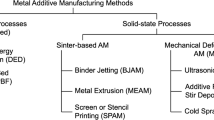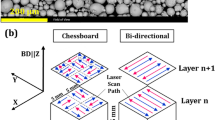Abstract: This study focuses on the influences of the fine particle fraction and the minimum particle size on the density, the shrinkage, the Young's modulus E, and the anisotropies of shrinkage and E. A lower minimum particle size and a higher fines content improved the particle packing, lubrication and sintering densification resulting in higher densities and E. Presumably due to a lower-density neutral zone after pressing, the anisotropic shrinkage was higher in the pressing direction, improving the density homogeneity. For the Young's modulus, the extent of the anisotropy increased mainly with a higher sintering capability (high fines content). Especially the core as a part of the neutral zone had a lower E. Exemplary density and open porosity distributions revealed that flaws formed in the core, which led to the lower E. The pressure distribution during uniaxial pressing leads to a density distribution and, finally, to a flaw density or flaw size distribution after sintering.






Similar content being viewed by others
References
Peters, S. (editor): Handbook of Composites. Chapman & Hall, 2nd ed. (1998) 687
German, R.: Powder metallurgy & Particulate materials processing. Metal Powder industries Federation (2005)
Briscoe, B., Rough, S.: The effects of wall friction in powder compaction. Colloids and Surfaces A: Physicochemical and Engineering Aspects (1998) [137] 103-16
Reed, J.: Principles of ceramic processing. John Wiley & Sons, Inc., 2nd ed. (1995).
Whittemore Jr., O.: Particle compaction. In: Onoda Jr., G.Y., Hench, L.L. (editors): Ceramic Processing before Firing. John Wiley & Sons, Inc. (1978) 343-55
Ewsuk, K., Argüello, J.: Controlled ceramic powder compaction through science-based understanding. Key Eng Mater (2004) [264-268] 149-54
Fruhstorfer, J., Aneziris, C.: Influence of particle size distributions on the density and density gradients in uniaxial compacts. Ceram Int (2017) [43] 13175-84
Hiestand, E.: Mechanical properties of compacts and particles that control tableting success. J Pharm Sci 86 (1997) [9] 985-90
Podczeck, F.: Investigations into the mechanical strength anisotropy of Sorbitol instant compacts made by uniaxial compression. Advanced Powder Technol 18 (2007) [4] 361-79
Fruhstorfer, J., Barlag, S., Thalheim, M., Schöttler, L., Aneziris, C.: Upright die pressing of refractory hollowware for steel ingot casting with reduced clay content. Ceram Int 42 (2016) [Part B] 3219-28
Fruhstorfer, J., Hubálková, J., Aneziris, C.G.: Particle packings minimizing density gradients of coarse-grained compacts. J Eur Ceram Soc 39 (2019) [10] 3264-76
Rhines, F.: Dynamic particle stacking. In: Onoda Jr., G.Y., Hench, L.L. (editors): Ceramic processing before firing. John Wiley & Sons (1978) 321-41
Kong, C., Lannutti, J.: Localized densification during the compaction of alumina granules: The stage I-II transition. J Am Ceram Soc 83 (2000) [4] 685-90
Glass, S., Ewsuk, K.: Ceramic powder compaction. MRS Bulletin 22 (1997) [12] 24-8
German, R.: Sintering Theory and Practice. John Wiley & Sons, 1st ed. (1996)
Lannutti, J.: Characterization and control of compact microstructure. MRS Bulletin (1997) [Dec] 38-44
Molinari, A., Torresani, E., Menapace, C., Larsson, M.: The anisotropy of dimensional change in sintering of iron. J Am Ceram Soc 98 (2015) [11] 3431-7.
Shui, A., Uchida, N., Uematsu, K.: Origin of shrinkage anisotropy during sintering for uniaxially pressed alumina compacts. Powder Technology (2002) [127] 9-18
Fruhstorfer, J., Aneziris, C.: The Influence of the Coarse Fraction on the Porosity of Refractory Castables. J Ceram Sci Tech 5 (2014) [2] 155-66
Kawamura, J., Hara, K., Kawasaki, K.: Survey for model of particle-size distribution and calculation of packing volume of multi-component particle size system in refractories batches. Yogyo-Kyokai-Shi 81 (1973) [9] 391-8
Kawamura, J., Ariyoshi, K., Yoshikata, T., Yamasaki, M.: Effect of particle-size distribution on characteristics of castable refractory. Yogyo-Kyokai-Shi 85 (1977) [3] 101-10
Fruhstorfer, J.: Continuous gap-graded particle packing designs. Mater Today Commun (2019) [20] 100550
Fruhstorfer, J.: Influence of the particle size distribution of coarse-grained refractories on the thermal shock performance. J Aust Ceram Soc (2021) [57] 899-909
Fruhstorfer, J.: Parsd - Tool to design and analyze particle size distributions. SoftwareX (2021) 100753.
Saharan, V., Kukkar, V., Kataria, M., Kharb, V., Choudhury, P.: Ordered mixing: mechanism, process and applications in pharmaceutical formulations. Asian J Pharm Sci 3 (2008) [6] 240-59
Coble, R., Kingery, W.: Effect of porosity on physical properties of sintered alumina. J Am Cer Soc 39 (1956) [11] 377-85
Montgomery, D.: Design and Analysis of Experiments. John Wiley & Sons, 5th ed. (2001)
R Development Core Team. R: A Language and Environment for Statistical Computing. R Foundation for Statistical Computing, Vienna, Austria (2010).
Myhre, B.: The effect of particle-size distribution on flow of refractory castables. In: The American Ceramic Society 30th Annual Refractories Symposium. St. Louis, Missouri (1994) 3-17
Phelps, G., McLaren, M.: Particle-size distribution and slip properties. In: Onoda Jr., G.Y., Hench, L. (editors): Ceramic Processing before Firing. John Wiley & Sons, Inc. (1978) 211-25
Furnas, C.: Grading Aggregates I - Mathematical Relations for Beds of Broken Solids of Maximum Density. Industrial and Engineering Chemistry 23 (1931) [9] 1052-8
Pivinskii, Y.: New refractory concrete and binding systems: Basic trends of development, production, and use of refractories in the 21st century. Part II. Ceramic binders and castables. Refractories and Industrial Ceramics 39 (1998) [3-4] 91-9
Fruhstorfer, J., Demuth, C., Goetze, P., Aneziris, C., Ray, S., Gross, U., Trimis, D.: How the coarse fraction influences the microstructure and the effective thermal conductivity of alumina castables - An experimental and numerical study. J Eur Ceram Soc (2018) [38] 303-12
Fruhstorfer, J., Möhmel, S., Thalheim, M., Schmidt, G., Aneziris, C.G.: Microstructure and strength of fused high alumina materials with 2.5wt% zirconia and 2.5wt% titania additions for refractory applications. Ceram Int (2015) [41] 10644-53
Acknowledgements
The authors thank the German Research Foundation (DFG) for supporting this study (grant number FR4317/1-1). The bricks were manufactured at the Professorship of Ceramics, TU Bergakademie Freiberg, Germany but analyzed at the Chair of Ceramics, Montanuniversität Leoben.
Author information
Authors and Affiliations
Rights and permissions
About this article
Cite this article
Fruhstorfer, J., Wagner, M., Gruber, D. et al. Influence of the Fine Fraction and Sintering on Selected Isotropic and Anisotropic Bulk Properties of Uniaxial Compacts. Interceram. - Int. Ceram. Rev. 71, 38–47 (2022). https://doi.org/10.1007/s42411-022-0482-3
Published:
Issue Date:
DOI: https://doi.org/10.1007/s42411-022-0482-3




